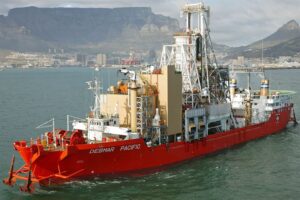Deep Sea Mining & Diamonds
Deep Sea Mining involves the extraction of valuable minerals from the ocean or seabed using specialised and sophisticated ships designed for the purpose of deep sea mining so that mining operations are not disrupted by unpredictable weather conditions that usually prevail and have the facilities on board to excavate deep into the ocean’s floor.These specialised mining vessels can stay at sea for months deployed at one area. Deep sea excavation is carried out for different minerals and polymetallic nodules containing significant amounts of manganese, cobalt, copper and nickel and other metals ( gold and silver ) . The famed Dutch conglomerate De Beers leads the world’s deep sea mining sector with an established and wide dashboard of mining operations extending from Africa to Canada.
Subsea Mining Jurisdictions & Licensing
 Credit;Mining Technology
Credit;Mining Technology
Mining ships can be operated only in those marine fields where subsea mining is permitted by marine authorities in both national as well as international jurisdictions and has no known significant impact on the deepwater ecosystem. The IUCN states that depletion of terrestrial mineral deposits is likely to increase even though research indicates that marine habitats may be destroyed especially as deep-sea ecosystems enable carbon sequestration.
International Seabed Authority
Norway is the first country to permit deep sea mining despite fierce opposition from its environmental lobby. Critical minerals present on the sea bed can be be extracted to combat climate change. The International Seabed Authority has granted 30 licenses across 5 areas to explore the seabed for valuable metals used in modern renewable technologies .Fish and octopus may be sucked up in the hose but appear to survive as they are returned to the sea . Greenpeace Aotearoa states that leaked undercover footage of wastewater pouring into the Pacific ocean during deep sea mining tests exposes the seabed mining industry greenwash and clearly indicates as to what extent deep sea mining damages the ocean’s health. Deep sea mining no doubt generates huge revenue streams and is all the more reason for the development of mining vessels which have specialised equipment and onboard systems even Roll on Roll Off vessels (ROVs) for varied activities of mining or possess underwater drilling capacity to drill 11,000 m below the sea surface , mapping of the sea bed, collecting metal and ore samples and gathering seismic data.
Mining ships possess advanced technologies to carry out the necessary operations which includes digital technologies to adjust to various mining operations alongside state-of-the-art systems like dynamic positioning systems and vessel tracking equipment. Generally mining vessels are broadly classified into two categories The first category is where mined raw materials are transported through a set of pipes and the second where the ship is positioned directly above the subsea excavation site.
The Namibian Government and diamond mining conglomerate De Beers in an equal share joint venture established in the year 2002 holds an offshore mining licence that has so far produced around 5 million carats of diamonds from the relatively shallow waters. Along the southwest coast of Namibia 5 specially designed mining vessels owned by De Beers operate to excavate diamonds washed into the Atlantic Ocean by the Orange River.
Types & Costs of Mining Vessels
The length of specialised deep sea mining ships ranges from over 300 feet to about 500 feet. The speed is adjusted prior to a maximum of about 11 knots as these vessels are required to remain steady in the deep sea where they are deployed . Mining vessels are frequently utilised to extract diamonds off the coast of South Africa or may be deployed to explore and excavate for copper, silver and gold used in manufacturing lithium ion batteries for electric vehicles and other renewable technologies. A Chinese shipyard has recently constructed its first seabed mining vessel and is capable of extracting copper and gold at a depth of 1600 m in the Bismarck Sea. A deep sea mining vessel averages 230 m long, 40 m wide with a gross tonnage of 50,000 and has the capacity to accommodate around 180 people.The modern vessels have a heat recovery system that produces fresh water onboard the ship. These ships usually have two main cranes for mining operations and a lifting system and can transfer ore to and from its ore storage hold to other ships. Some ships may have a bulk cutter which operates at very low temperatures to prevent excessive heating.
Remotely Operated Mining Vessels
Newer models of mining vessels can sail without going to berth for four months and have several labs and equipments on board as well as R.M.R. System, which decreases drilling’s environmental impact while improving drilling efficiency. Some deep sea mining vessels have a 240-tonne crawler used for mining and an onboard recovery plant which can process 250 tonnes of water and gravel mixture hourly . Remotely operated vessels can mine more than 1000 m2 in one hour and transport around 1600 tonnes of sand containing diamonds into the processing plant with powerful pumps to suck the sand and a strong jetting system to loosen the sediment and can stay underwater for over a week while working 24 hours without any operational break.
Cost estimates for construction of deep sea mining vessels vary and one such vessel which was designed in Poland and Norway and constructed in Romania, the Benguela Gem ,cost almost $ 486 million .This vessel’s life is expected to be 3 decades adding about half a million carats of diamonds to De beers annual production so the internal rate of return is phenomenal .
Another of the diamond conglomerates exploration and sampling vessel is 113 m long and 22 m wide and weighs 12,000 tonnes and was constructed in Ulsteinvik , Norway at a cost of $ 157 million and can remain at sea for 3 years at a stretch and is designed to reduce carbon footprint.
By Nadir Mumtaz
Credit/Sources ;
https://www.iucn.org/resources/issues-brief/deep-sea-mining
https://www.reuters.com/graphics/MINING-DEEPSEA/CLIMATE/zjpqezqzlpx/
https://www.marineinsight.com/types-of-ships/mining-ships-in-the-world/

Leave A Comment